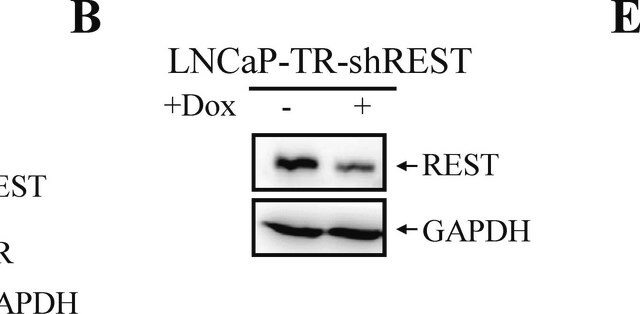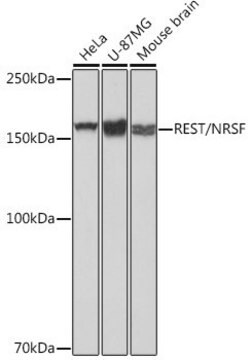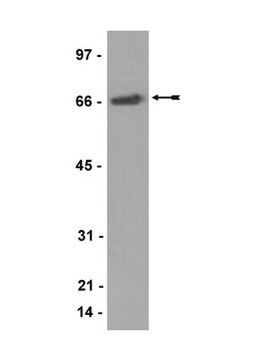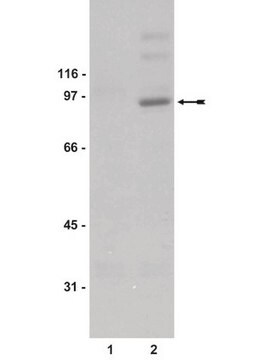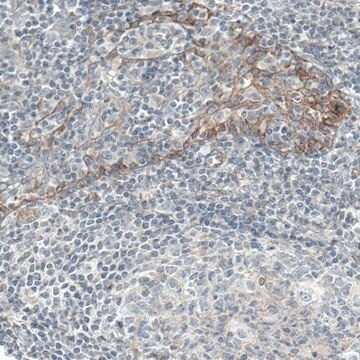07-579
Anti-REST Antibody
Upstate®, from rabbit
Synonym(s):
Neural-restrictive silencer factor, RE1-silencing transcription factor, X2 box repressor, neuron restrictive silencer factor, repressor binding to the X2 box
About This Item
Recommended Products
biological source
rabbit
Quality Level
antibody form
purified immunoglobulin
antibody product type
primary antibodies
clone
polyclonal
species reactivity
human
manufacturer/tradename
Upstate®
technique(s)
western blot: suitable
isotype
IgG
NCBI accession no.
UniProt accession no.
shipped in
wet ice
target post-translational modification
unmodified
Gene Information
human ... REST(5978)
mouse ... Rest(19712)
rat ... Rest(83618)
General description
Specificity
Immunogen
Application
Epigenetics & Nuclear Function
Transcription Factors
From the summary:
"Finally, the glycosylation pattern of the REST protein was analysed, moving from the observation that the molecular weight calculated on REST sequence is about 116 kDa but using western blotting this transcription factor appears to have distinct apparent molecular weight (see Table 1.1): this difference could be explained by post-translational modifications of the proteins, like glycosylation. In fact recently, several studies underlined the importance of O-glycosylation in modulating transcriptional silencing, protein phosphorylation, protein degradation by proteasome and protein–protein interactions [Julenius et al., 2005; Zachara and Hart, 2006]. Deglycosilating analysis showed that REST protein in SH-SY5Y and HEK293 cells is Oglycosylated and not N-glycosylated. Moreover, using several combination of deglycosilating enzymes it is possible to hypothesize the presence of Gal-β(1-3)-GalNAc residues on the endogenous REST, while β(1-4)-linked galactose residues may be present on recombinant REST protein expressed in HEK293 cells. However, the O-glycosylation process produces an immense multiplicity of chemical structures and monosaccharides must be sequentially hydrolyzed by a series of exoglycosidase. Further experiments are needed to characterize all the post-translational modification of the transcription factor REST." In particular the authors show that REST migrates at 200kd in SH-SY5Y cells.
Quality
Target description
Physical form
Storage and Stability
Analysis Note
Positive Antigen Control: Catalog #12-309, Hela cell nuclear extract. Add an equal volume of Laemmli reducing sample buffer to 10 μL of extract and boil for 5 minutes to reduce the preparation. Load 20 μg of reduced extract per lane for minigels.
Other Notes
Legal Information
Disclaimer
Not finding the right product?
Try our Product Selector Tool.
recommended
Storage Class Code
12 - Non Combustible Liquids
WGK
WGK 2
Flash Point(F)
Not applicable
Flash Point(C)
Not applicable
Certificates of Analysis (COA)
Search for Certificates of Analysis (COA) by entering the products Lot/Batch Number. Lot and Batch Numbers can be found on a product’s label following the words ‘Lot’ or ‘Batch’.
Already Own This Product?
Find documentation for the products that you have recently purchased in the Document Library.
Our team of scientists has experience in all areas of research including Life Science, Material Science, Chemical Synthesis, Chromatography, Analytical and many others.
Contact Technical Service